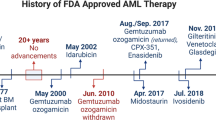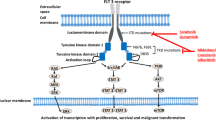Opinion statement
Defects in the core regulators of the apoptosis pathway contribute to chemoresistance and poor outcomes in patients with acute myeloid leukemia (AML). To overcome these defects, novel molecules that target key proteins in the mitochondrial, death receptor, and convergence pathways of caspase activation are being developed. This review will highlight selected molecules including Bcl-2 and XIAP inhibitors that are advanced stages of development and have entered clinical trial for AML. In addition, this review will discuss how these novel therapies are being used as chemical probes to better understand the biology of the apoptosis pathway.
Similar content being viewed by others
References and Recommended Reading
Papers of particular interest, published recently, have been highlighted as: •Of importance ••Of major importance
Moore JO, George SL, Dodge RK, Amrein PC, Powell BL, Kolitz JE, et al.: Sequential multiagent chemotherapy is not superior to high-dose cytarabine alone as postremission intensification therapy for acute myeloid leukemia in adults under 60 years of age: Cancer and Leukemia Group B Study 9222. Blood 2005, 105(9):3420–3427.
Boatright KM, Renatus M, Scott FL, Sperandio S, Shin H, Pedersen IM, et al.: A unified model for apical caspase activation. Mol Cell 2003, 11:529–541.
Pop C, Fitzgerald P, Green DR, Salvesen GS.: Role of proteolysis in caspase-8 activation and stabilization. Biochemistry 2007, 46(14):4398–4407.
Schimmer A, Hedley DW, Penn LZ, Minden MD.: Receptor- and mitochondrial-mediated apoptosis in acute leukemia: a translational view. Blood 2001, 98:3541–3553.
Pop C, Timmer J, Sperandio S, Salvesen GS.: The apoptosome activates caspase-9 by dimerization. Mol Cell 2006, 22(2):269–275.
Reed JC.: Proapoptotic multidomain Bcl-2/Bax-family proteins: mechanisms, physiological roles, and therapeutic opportunities. Cell Death Differ 2006, 13(8):1378–1386.
Schimmer AD, Dalili S, Batey RA, Riedl SJ.: Targeting XIAP for the treatment of malignancy. Cell Death Differ 2006, 13(2):179–188.
Tothova E, Fricova M, Stecova N, Kafkova A, Elbertova A.: High expression of Bcl-2 protein in acute myeloid leukemia cells is associated with poor response to chemotherapy. Neoplasma 2002, 49(3):141–144.
Del Poeta G, Venditti A, Del Principe MI, Maurillo L, Buccisano F, Tamburini A, et al.: Amount of spontaneous apoptosis detected by Bax/Bcl-2 ratio predicts outcome in acute myeloid leukemia (AML). Blood 2003, 101(6):2125–2131.
Kornblau SM, Vu HT, Ruvolo P, Estrov Z, O’Brien S, Cortes J, et al.: Bax and PKCa modulate the prognostic impact of BCL2 expression in acute myelogenous leukemia. Clin Can Res 2000, 6:1401–1409.
Konopleva M, Tari A, Estrov Z, Harris D, Xie Z, Zhao S, et al.: Liposomal Bcl-2 antisense oligonucleotides enhance proliferation, sensitize AML to cytosine-arabinoside, and induce apoptosis independent of other anti-apoptotic proteins. Blood 2000, 95(12):3929–3938
O’Brien S, Moore JO, Boyd TE, Larratt LM, Skotnicki A, Koziner B, et al.: Randomized phase III trial of fludarabine plus cyclophosphamide with or without oblimersen sodium (Bcl-2 antisense) in patients with relapsed or refractory chronic lymphocytic leukemia. J Clin Oncol 2007, 25(9):1114–1120.
This important paper reports the results of randomized clinical trial of salvage chemotherapy with and without Bcl-2 antisense oligonucleotides for patients with relapsed/refractory CLL. Bcl-2 antisense oligonucleotides increased response rates but did not change overall survival.
Bedikian AY, Millward M, Pehamberger H, Conry R, Gore M, Trefzer U, et al.: Bcl-2 antisense (oblimersen sodium) plus dacarbazine in patients with advanced melanoma: the Oblimersen Melanoma Study Group. J Clin Oncol 2006, 24(29):4738–4745.
Marcucci G, Stock W, Dai G, Klisovic RB, Liu S, Klisovic MI, et al. Phase I study of oblimersen sodium, an antisense to Bcl-2, in untreated older patients with acute myeloid leukemia: pharmacokinetics, pharmacodynamics, and clinical activity. J Clin Oncol 2005, 23(15):3404–3411.
Trudel S, Li ZH, Rauw J, Tiedemann RE, Wen XY, Stewart AK.: Pre-clinical studies of the pan-Bcl inhibitor obatoclax (GX015–070) in multiple myeloma. Blood 2007, 109(12):5430–5438
Shore GC, Viallet J.: Modulating the bcl-2 family of apoptosis suppressors for potential therapeutic benefit in cancer. Hematol Am Soc Hematol Educ Program 2005, 226–230.
Oltersdorf T, Elmore SW, Shoemaker AR, Armstrong RC, Augeri DJ, Belli BA, et al.: An inhibitor of Bcl-2 family proteins induces regression of solid tumours. Nature 2005, 435(7042):677–681.
This seminal paper describes the rationale design of a small molecule inhibitor of Bcl-2 based on SAR through NMR. The lead compound ABT-737 induces apoptosis, sensitizes cells to chemotherapy, and delays tumor growth in xenografts.
Pukac L, Kanakaraj P, Humphreys R, Alderson R, Bloom M, Sung C, et al.: HGS-ETR1, a fully human TRAIL-receptor 1 monoclonal antibody, induces cell death in multiple tumour types in vitro and in vivo. Br J Cancer 2005, 92(8):1430–1441.
Tolcher AW, Mita M, Meropol NJ, von Mehren M, Patnaik A, Padavic K, et al.: Phase I pharmacokinetic and biologic correlative study of mapatumumab, a fully human monoclonal antibody with agonist activity to tumor necrosis factor-related apoptosis-inducing ligand receptor-1. J Clin Oncol 2007, 25(11):1390–1395.
Wuchter C, Krappmann D, Cai Z, Ruppert V, Scheidereit C, Dorken B, et al.: In vitro susceptibility to TRAIL-induced apoptosis of acute leukemia cells in the context of TRAIL receptor gene expression and constitutive NF-kappa B activity. Leukemia 2001, 15(6):921–928.
Interesting paper that highlights the likely limited utility of TRAIL as a single agent for the treatment of AML.
Guo F, Sigua C, Tao J, Bali P, George P, Li Y, et al.: Cotreatment with histone deacetylase inhibitor LAQ824 enhances Apo-2L/tumor necrosis factor-related apoptosis inducing ligand-induced death inducing signaling complex activity and apoptosis of human acute leukemia cells. Cancer Res 2004, 64(7):2580–2589.
Druker BJ, Guilhot F, O’Brien SG, Gathmann I, Kantarjian H, Gattermann N, et al.: Five-year follow-up of patients receiving imatinib for chronic myeloid leukemia. N Engl J Med 2006, 355(23):2408–2417.
Faivre S, Djelloul S, Raymond E.: New paradigms in anticancer therapy: targeting multiple signaling pathways with kinase inhibitors. Semin Oncol 2006, 33(4):407–420.
Maione P, Gridelli C, Troiani T, Ciardiello F.: Combining targeted therapies and drugs with multiple targets in the treatment of NSCLC. Oncologist 2006, 11(3):274–284.
Suh N, Wang Y, Honda T, Gribble GW, Dmitrovsky E, Hickey WF, et al.: A novel synthetic oleanane triterpenoid, 2-cyano-3,12-dioxoolean-1,9-dien-28-oic acid, with potent differentiating, antiproliferative, and anti-inflammatory activity. Cancer Res 1999, 59:336–341.
Ito Y, Pandey P, Place A, Sporn MB, Gribble GW, Honda T, et al.: The novel triterpenoid 2-cyano-3,12-dioxoolean-1,9-dien-28-oic acid induces apoptosis of human myeloid leukemia cells by a caspase-8-dependent mechanism. Cell Growth Differ 2000, 11:261–267.
Yore MM, Liby KT, Honda T, Gribble GW, Sporn MB.: The synthetic triterpenoid 1-[2-cyano-3,12-dioxooleana-1,9(11)-dien-28-oyl]imidazole blocks nuclear factor-kappaB activation through direct inhibition of IkappaB kinase beta. Mol Cancer Ther 2006, 5(12):3232–3239.
Yates MS, Kwak MK, Egner PA, Groopman JD, Bodreddigari S, Sutter TR, et al.: Potent protection against aflatoxin-induced tumorigenesis through induction of Nrf2-regulated pathways by the triterpenoid 1-[2-cyano-3-,12-dioxooleana-1,9(11)-dien-28-oyl]imidazole. Cancer Res 2006, 66(4):2488–2494.
Liby K, Hock T, Yore MM, Suh N, Place AE, Risingsong R, et al.: The synthetic triterpenoids, CDDO and CDDO-imidazolide, are potent inducers of heme oxygenase-1 and Nrf2/ARE signaling. Cancer Res 2005, 65(11):4789–4798.
Zou W, Liu X, Yue P, Zhou Z, Sporn MB, Lotan R, et al.: c-Jun NH2-terminal kinase-mediated up-regulation of death receptor 5 contributes to induction of apoptosis by the novel synthetic triterpenoid methyl-2-cyano-3,12-dioxooleana-1, 9-dien-28-oate in human lung cancer cells. Cancer Res 2004, 64(20):7570–7578.
Yue P, Zhou Z, Khuri FR, Sun SY.: Depletion of intracellular glutathione contributes to JNK-mediated death receptor 5 upregulation and apoptosis induction by the novel synthetic triterpenoid methyl-2-cyano-3, 12-dioxooleana-1, 9-dien-28-oate (CDDO-Me). Cancer Biol Ther 2006, 5(5):492–497.
Stadheim TA, Suh N, Ganju N, Sporn M, Eastman A.: The novel triterpenoid, 2-cyano-3,12-dioxooleana-1,9-dien-28-oic acid (CDDO), potently enhances apoptosis induced by tumor necrosis factor in human leukemia cells. J Biol Chem 2002, 277(19):1648–1655
Suh WS, Kim YS, Schimmer AD, Kitada S, Minden M, Andreeff M, et al.: Synthetic triterpenoids activate a pathway for apoptosis in AML cells involving downregulation of FLIP and sensitization to TRAIL. Leukemia 2003, 17(11):2122–2129.
Pedersen IM, Kitada S, Schimmer A, Kim Y, Zapata JM, Charboneau L, et al.: The triterpenoid CDDO induces apoptosis in refractory CLL B-cells. Blood 2002, 100:2965–2972.
Wilkinson JC, Cepero E, Boise LH, Duckett CS.: Upstream regulatory role for XIAP in receptor-mediated apoptosis. Mol Cell Biol 2004, 24(16):7003–7014.
Berezovskaya O, Schimmer AD, Glinskii AB, Pinilla C, Hoffman RM, Reed JC, et al.: Increased expression of apoptosis inhibitor protein XIAP contributes to anoikis resistance of circulating human prostate cancer metastasis precursor cells. Cancer Res 2005, 65(6):2378–2386.
Tong QS, Zheng LD, Wang L, Zeng FQ, Chen FM, Dong JH, et al.: Downregulation of XIAP expression induces apoptosis and enhances chemotherapeutic sensitivity in human gastric cancer cells. Cancer Gene Ther 2005, 12(5):509–514
Tamm I, Richter S, Scholz F, Schmelz K, Oltersdorf D, Karawajew L, et al.: XIAP expression correlates with monocytic differentiation in adult de novo AML: impact on prognosis. Hematol J 2004, 5(6):489–495.
Tamm I, Richter S, Oltersdorf D, Creutzig U, Harbott J, Scholz F, et al.: High expression levels of x-linked inhibitor of apoptosis protein and survivin correlate with poor overall survival in childhood de novo acute myeloid leukemia. Clin Cancer Res 2004, 10(11):3737–3744.
Hu Y, Cherton-Horvat G, Dragowska V, Baird S, Korneluk RG, Durkin JP, et al.: Antisense oligonucleotides targeting XIAP induce apoptosis and enhance chemotherapeutic activity against human lung cancer cells in vitro and in vivo. Clin Cancer Res 2003, 9(7):2826–2836.
LaCasse EC, Cherton-Horvat GG, Hewitt KE, Jerome LJ, Morris SJ, Kandimalla ER, et al.: Preclinical characterization of AEG35156/GEM 640, a second-generation antisense oligonucleotide targeting X-linked inhibitor of apoptosis. Clin Cancer Res 2006, 12(17):5231–5241.
Sun H, Nikolovska-Coleska Z, Yang CY, Xu L, Tomita Y, Krajewski K, et al.: Structure-based design, synthesis, and evaluation of conformationally constrained mimetics of the second mitochondria-derived activator of caspase that target the X-linked inhibitor of apoptosis protein/caspase-9 interaction site. J Med Chem 2004, 47(17):4147–4150.
Sun H, Nikolovska-Coleska Z, Yang CY, Xu L, Liu M, Tomita Y, et al.: Structure-based design of potent, conformationally constrained Smac mimetics. J Am Chem Soc 2004, 126(51):16686–16687.
Nikolovska-Coleska Z, Xu L, Hu Z, Tomita Y, Li P, Roller PP, et al.: Discovery of embelin as a cell-permeable, small-molecular weight inhibitor of XIAP through structure-based computational screening of a traditional herbal medicine three-dimensional structure database. J Med Chem 2004, 47(10):2430–2440.
Li L, Thomas RM, Suzuki H, De Brabander JK, Wang X, Harran PG. A small molecule Smac mimic potentiates TRAIL- and TNFalpha-mediated cell death. Science 2004, 305(5689):1471–1474.
Wu TY, Wagner KW, Bursulaya B, Schultz PG, Deveraux QL.: Development and characterization of nonpeptidic small molecule inhibitors of the XIAP/caspase-3 interaction. Chem Biol 2003, 10(8):759–767.
Schimmer AD, Welsh K, Pinilla C, Wang Z, Krajewska M, Bonneau MJ, et al.: Small-molecule antagonists of apoptosis suppressor XIAP exhibit broad antitumor activity. Cancer Cell 2004, 5(1):25–35.
Carter BZ, Gronda M, Wang Z, Welsh K, Pinilla C, Andreeff M, et al.: Small-molecule XIAP inhibitors derepress downstream effector caspases and induce apoptosis of acute myeloid leukemia cells. Blood 2005, 105(10):4043–4050.
Acknowledgments
This work was supported by Ontario Cancer Research Network through funding provided by the Province of Ontario, and the Leukemia and Lymphoma Society. A.D.S. is the recipient of a CIHR Clinician Scientist Award.
Author information
Authors and Affiliations
Corresponding author
Rights and permissions
About this article
Cite this article
Schimmer, A.D. Novel Therapies Targeting the Apoptosis Pathway for the Treatment of Acute Myeloid Leukemia. Curr. Treat. Options in Oncol. 8, 277–286 (2007). https://doi.org/10.1007/s11864-007-0037-x
Published:
Issue Date:
DOI: https://doi.org/10.1007/s11864-007-0037-x




